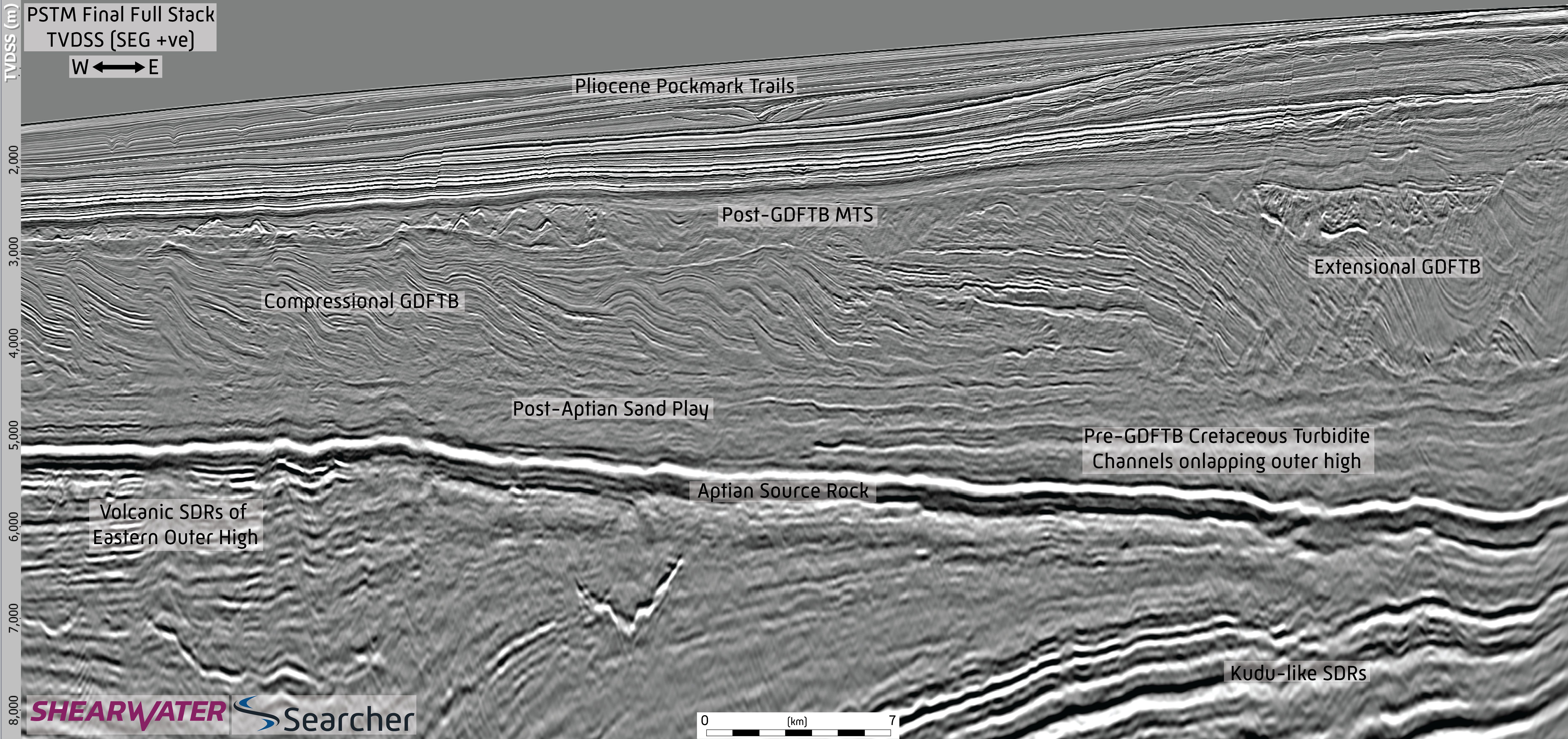3D that’s fast, cheap and good! And all three together in the Hottest basin on Earth
So far this year, approximately 18,000 square km of new 3D was acquired in the white-hot Orange Basin of Namibia, aiming to delineate the Venus and Graff plays and constrain similar related plays and development opportunities in the basin.
6,700 square km of this 3D data was multi-client, the first of which was acquired over PEL85, operated by Rhino Resources. The Shearwater Empress towed 12 streamers each 8.1 km long and 150 m apart, commonly known as a wide tow configuration, in late 2022 to early 2023.
Shearwater are processing the data and yet only one month after the last shot point of the survey, were able to deliver an extraordinarily well-imaged fast-track depth converted PostSTM 3D volume, with a full set of angle stacks. Some seven months later a full PSTM was delivered, see example in fold out, and final PSDM will be delivered by November 2023. The processing results even from the fast track are superb, where rapid access to 3D data is crucial in a basin where a steady stream of discoveries and drilling activity is constantly changing the prospectivity story.

The journey begins: The framework
PEL85 is located updip of the Graff and La Rona discoveries. The lowest part of the section shown in the foldout line is comprised of Seaward Dipping Reflectors (SDRs), both mixed clastic and volcanic in the east with “Kudu Field” type set of lithologies, and purely volcanic in the west.
Above the unconformity at the top of the SDRs lies a thick Lower Cretaceous section at the top of which is a decollement surface marking the base of the Orange Basin’s famous Gravity Driven Fold and Thrust Belt (GDFTB). As we will see, substantial targets lie below the GDFTB. However, a variety of prospects are mapped in the compressional, translational and extensional sections of the GDFTB too. Above this is a thin but significant Mass Transport Complex (MTC) which is significant as it provides topseal to buried topology plays.
Above the GDFTB and the MTC, the Tertiary sequence marks a transition from the “collapse-a-thon” of the unstable Late Cretaceous Orange shelf to a period of stability. This is related to a dynamic topography effect on the basin as South Africa rotated over a mantle upwelling. Elliptical seabed depressions at seabed are in fact formed as trails of pockmarks migrating down slope related to the presence of oil in deeper reservoirs, as seen on figures 1a and b. They are associated with narrow fluid flow pipes and vents and small sections of Bottom Simulating Reflectors (BSRs), indicating near surface gas hydrate accumulations.
We need to talk about the Early Cretaceous
Lower Cretaceous Aptian source rock lies on top of the SDR packages; see yellow horizon on the foldout.
It is low frequency, low amplitude, almost isopachous across the section with only some thinning towards the western high. In age, we suspect it is similar to the Aptian source rock penetrated by the Wingat-1 well and may be equivalent to the upper part of the Aptian source under Venus deposited in-board of the outer high as drift subsidence in the Aptian allowed flooding, peneplanation and then deposition of source rock over the volcanic-SDR, and clastic SDR units of the early post rift and late syn-rift respectively.
Early analysis of this unit shows it is thick, omnipresent and displays a strong negative far angle minus near angle times far angle response (F-N*F) indicating a Type IV AVO anomaly which is also identified on the gradient versus intercept plot and is associated, especially in Namibia, with an oil generative source rock.

Between the Aptian source rock (yellow horizon on the foldout) and the overlying GDFTB lies a conformable section, within which we map a number of high amplitude channels running broadly NE to SW across the block. The amplitude anomalies in these channel systems map out over 30 to 90 square km in extent, and we suggest that these channels would be similar to those feeding sand into the Graff and La Rhona discoveries. Graff is reported to have complex trapping, including sub-GDFTB thrusting and mixed system interaction between slope channels and contourite drifts/current.
Some sub-GDFTB structuration is apparent on the data here, and contourite influence, in particular the ability to winnow turbidites to improve net/gross, would not be unwelcome. On this dataset these onlapping, counter-regional dipping traps are associated with very strong positive F-N*F attribute responses indicating the presence of hydrocarbons. Sitting as they do over Aptian source rock, buried sufficiently to be well in the oil generative window, these features look attractive already, and no doubt the diligent geoscience from the Rhino Resources team will find that they are even more irresistible in the near future.
Bring on more data!
These extraordinary results will soon be added to by another 20,000 square km more multi-client 3D being collected in the 2023-2024 season in this basin. These 3D’s across the basin will allow the industry to map, understand and make investment decisions with a knowledge of how the whole basin is working, and for once, being able to see all the cards in play rather than just the data in their own hands.
That Rhino Resources took the first step to get new data to redefine the hydrocarbon story is a great credit to them, and together with spectacular seismic acquisition and processing from Shearwater has paved the way for the industry to explore this exciting play fairway. This makes the point; early multi-client seismic plays a key role in re-writing the futures exploration story.





